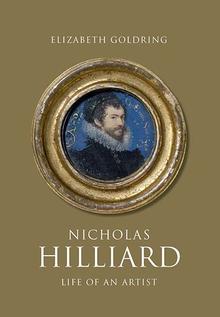 Elizabeth Goldring is an honorary associate professor at the Centre for the Study of the Renaissance at the University of Warwick and a fellow of the Royal Historical Society.
Elizabeth Goldring is an honorary associate professor at the Centre for the Study of the Renaissance at the University of Warwick and a fellow of the Royal Historical Society.Here she dreamcasts an adaptation of her new book, Nicholas Hilliard: Life of an Artist:
Nicholas Hilliard: Life of an Artist tells the story of Nicholas Hilliard, portrayer of Elizabeth I, James I, and their courts. Born into a family of Devon goldsmiths at the tail-end of Henry VIII’s reign, Hilliard lived an exceptionally long and rich life, notable for the wide range of people he met and portrayed, as well as for his own journey to the heart of the English court – and, indeed, to the heart of the French court, where he spent about two and a half years as a court painter (in all probability doing a bit of spying for Elizabeth I on the side).Learn more about Nicholas Hilliard: Life of an Artist at the Yale University Press website.
Hilliard’s fame derives chiefly from his exquisitely detailed portrait miniatures: tiny images painted in watercolour on vellum using a brush made from squirrel hairs set in a bird quill. Most are no bigger than the lid of jam jar, though some are as small as a watch-face. In an era long before the invention of the photograph – much less the instantly communicable imagery of the mobile telephone – portrait miniatures had the great virtue of being easily portable and thus of helping to create intimacy (or the illusion thereof) across long distances. Hilliard was the first native-born English artist to acquire a reputation for excellence both at home, where poets such as John Donne sang his praises, and abroad, where his paintings were admired by the Medici, the Valois, and the Habsburgs. In addition to kings and queens, Hilliard’s sitters included royal favourites the earls of Leicester and Essex; Shakespeare’s patron the earl of Southampton; the explorers Sir Francis Drake and Sir Walter Ralegh; and members of the aspirational middle class from which Hilliard himself hailed.
My book traces Hilliard’s rise to fame, his personal struggles and quest to become the social equal of his aristocratic sitters, his role as teacher to the next generation of English painters, and his influence on writers such as Donne. In addition, it brings to life the political and religious upheavals of the age. But a film adaptation – rather than trying to recount all seventy-two years of Hilliard’s turbulent life and times – would perhaps be most effective if it focused on the thirty-two-year relationship between Hilliard and Elizabeth I.
Prior to Hilliard’s appearance on the scene, Elizabeth had been highly self-conscious about her image, particularly when exchanging portraits with Mary Queen of Scots, a legendary beauty who had some of the most gifted painters at the French court at her disposal. But Hilliard gave Elizabeth a makeover and, virtually overnight, emerged as her most trusted portraitist. Between 1571, the year in which he first portrayed Elizabeth from the life (a time-consuming business which meant spending three or four days together), and 1603, the year in which she died, Hilliard produced hundreds of portraits of Elizabeth. Hilliard knew how to flatter. All the portraits that he painted of Elizabeth towards the end of her life – by which stage she had lost most of her teeth and hair – depict her as an eternally youthful, wrinkle-free maiden, with glorious golden-red ringlets. Yet in spite of Hilliard’s many years of faithful service, Elizabeth was slow to pay – which, when coupled with Hilliard’s expensive tastes (to say nothing of the fact that he and his wife had seven children), meant that he frequently found himself on the run from creditors or doing business with less-than-salubrious characters.
My dream casting would be Benedict Cumberbatch as Hilliard and Gillian Anderson as Elizabeth I. Both are gifted actors and particularly good in period pieces. There is also, in each case, a strong physical resemblance to the historical figure to be portrayed – something which, though not essential, is always a bonus.
--Marshal Zeringue





